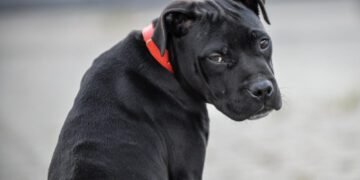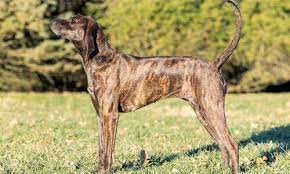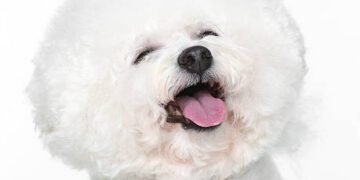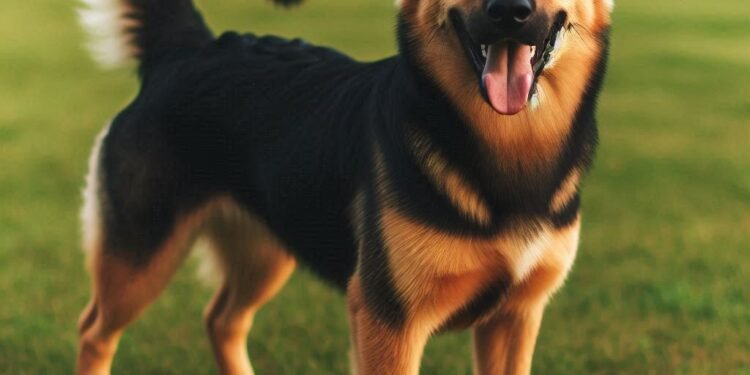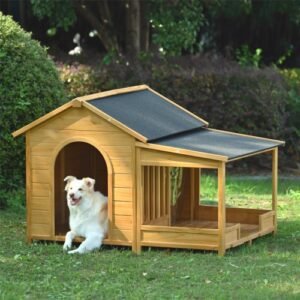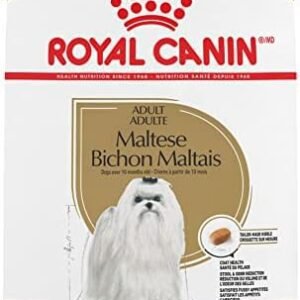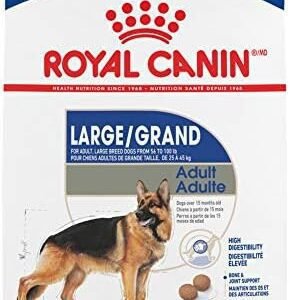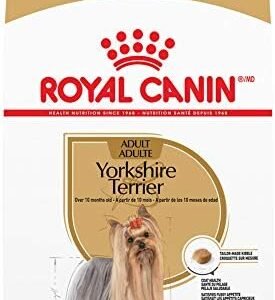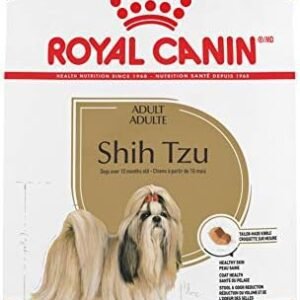The German Sheprador is a fascinating hybrid dog breed that combines the traits of the German Shepherd and the Labrador Retriever. This section will provide an engaging introduction to this unique breed, highlighting its distinctiveness and the importance of selecting the right breed for your lifestyle.
A Blend of Excellence: Picture a dog that combines the protective instincts of the German Shepherd with the friendly and loving nature of the Labrador Retriever. The German Sheprador offers the perfect fusion of these two remarkable breeds.
Table of Contents
Understanding the German Sheprador Breed
The German Sheprador, often referred to as the “Labrashepherd,” is a hybrid breed known for its versatility, intelligence, and unwavering loyalty. This breed results from crossing a German Shepherd with a Labrador Retriever, two of the most beloved and popular dog breeds worldwide. This unique combination results in a dog that excels in various roles, making it a sought-after choice for families and individuals alike.
Why Choose the Right Breed?
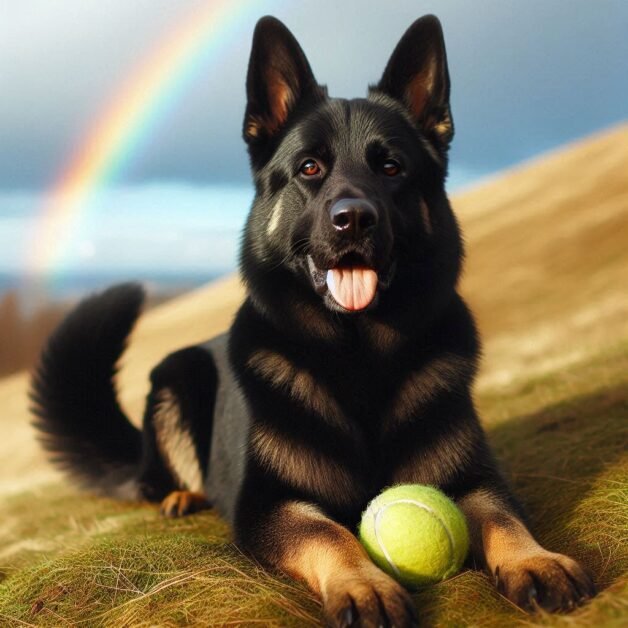
Selecting the right dog breed is a crucial decision, as it significantly influences your dog’s behavior, needs, and compatibility with your lifestyle. Each breed possesses a unique set of characteristics, including temperament, exercise requirements, and grooming needs. The German Sheprador, with its distinct blend of traits, offers a compelling option for those seeking a loyal, intelligent, and versatile canine companion.
The following table explains about the different characteristics of the German Sheprador dog breed:
| Field | Information about the German Sheprador |
|---|---|
| Height | Not known |
| Weight | Not known |
| Life Span | Not known |
| Good with | Families, active individuals |
| Temperament | Loyal, intelligent, friendly |
| Intelligence | High |
| Shedding Amount | Moderate to high |
| Grooming | Regular grooming required |
| Exercise Needs | High |
| Energy Level | High |
| Barking Level | Moderate |
| Drool Amount | Low |
| Coat Length/Texture | Short to medium, dense, double coat |
| Colors | Various, including black, brown, yellow |
| Patterns | Solid colors, occasionally bi-colored |
This comprehensive table outlines key characteristics of the German Sheprador breed. Despite some unknown data, it provides valuable insights into the breed’s temperament, exercise needs, and grooming requirements. The German Sheprador’s unique blend of German Shepherd and Labrador Retriever traits makes it an extraordinary companion.
Breed History and Origin
Exploring Their Roots
To truly understand the German Sheprador breed, it’s essential to delve into its rich historical development. This hybrid breed’s history is shaped by the heritage of its parent breeds, the German Shepherd and the Labrador Retriever. Let’s explore its origins:
Notable Traits
The German Sheprador inherits several notable traits from its parent breeds, making it a unique and versatile hybrid. These traits set it apart in the world of canine companions:
Loyalty: Like its German Shepherd parent, the German Sheprador is exceptionally loyal to its family. This loyalty makes it a loving and protective companion.
Intelligence: The German Shepherd’s intelligence is well-known, and the German Sheprador inherits this trait. They are quick learners, making them excellent problem solvers and eager participants in training.
Friendly Nature: The Labrador Retriever’s friendly and sociable nature is a prominent trait in the German Sheprador. They tend to get along well with both their human family and other pets, making them great for families.
Versatility: With a blend of protective instincts and a gentle disposition, the German Sheprador is versatile. They can excel in various roles, from a loyal family pet to a reliable working dog.
Strong Work Ethic: Both parent breeds are known for their strong work ethic, and the German Sheprador is no exception. They thrive when they have a job to do and are mentally and physically stimulated.
Relevance of Origin
The origin of the German Sheprador plays a significant role in shaping its characteristics today. The German Shepherd’s history as a herding and working dog has influenced the German Sheprador’s intelligence, loyalty, and protective instincts. The Labrador Retriever’s background as a retriever and companion has contributed to the breed’s friendly and sociable nature.
Understanding the historical roots of the German Sheprador helps us appreciate the unique blend of traits it offers. Whether you’re captivated by its loyalty, intelligence, or versatility, the German Sheprador is a remarkable breed with a rich heritage. In the following sections, we will delve into the physical attributes, temperament, health considerations, and care requirements of the German Sheprador. Stay tuned for more insights!
Understanding the German Sheprador Breed’s Traits
Physical Characteristics
The German Sheprador is an impressive breed that exhibits a blend of physical attributes inherited from its German Shepherd and Labrador Retriever parents. Here, we’ll dive into the breed’s key physical characteristics:
Size: The size of a German Sheprador can vary, but they are generally a medium to large breed. They typically stand between 20 to 27 inches (51 to 69 cm) tall at the shoulder and weigh anywhere from 50 to 95 pounds (23 to 43 kg). This variation can be attributed to the different sizes of their parent breeds.
Coat Type: German Shepradors typically have a dense, double coat that helps protect them in various weather conditions. Their coat is generally short to medium in length, providing them with some insulation. The coat’s texture can range from coarse to soft, depending on the genes inherited from their parents.
Color: The German Sheprador’s coat comes in a variety of colors, including black, brown, yellow, and combinations of these. They may have a solid coat or occasionally display bi-colored patterns. The exact coat color and pattern can vary from one dog to another.
Distinguishing Features: While there are no unique distinguishing features specific to the German Sheprador, their appearance often reflects a combination of traits from their parent breeds. They may have expressive, almond-shaped eyes and floppy ears. Their tail is usually long and may have a slight curl.
Temperament Overview
The German Sheprador’s temperament is a captivating blend of traits that make them an ideal choice for many families. Here’s an overview of their temperament:
Family-Friendly: German Shepradors are known for their friendly and sociable nature, which they inherit from their Labrador Retriever parent. They tend to get along well with family members, including children. Their loyalty and protectiveness often make them excellent companions for families.
Compatibility with Other Pets: While they may have protective instincts from the German Shepherd side, early socialization can help German Shepradors get along with other pets in the household. Proper introductions and positive experiences can contribute to their compatibility with other animals.
Environmental Needs: German Shepradors can adapt well to various environments. They thrive in homes with yards where they can expend their energy, but they can also adapt to apartment living if provided with regular exercise. They are sensitive to temperature extremes and should not be exposed to harsh weather conditions.
Suitability as Family Pets: With their friendly and loving nature, German Shepradors are well-suited as family pets. They enjoy being part of the family activities and form strong bonds with their human companions. Their intelligence and trainability make them great for families looking for an obedient and loyal canine companion.
Common Behavioral Traits
German Shepradors exhibit a range of behavioral traits, some of which are common to the breed, while others are more individual. Here are some key behavioral traits to consider:
Loyalty: This breed is exceptionally loyal to its family. They often form strong attachments to their human members and are protective of them.
Intelligence: German Shepradors are highly intelligent, thanks to their German Shepherd lineage. This intelligence makes them quick learners and eager participants in training.
Energetic: With their Labrador Retriever energy, German Shepradors are full of vitality. They require regular exercise to stay happy and healthy. Daily walks and playtime are essential.
Protectiveness: German Shepradors may exhibit protective instincts, particularly if they sense a threat to their family. Early socialization and training can help manage this trait.
Obedience: They tend to be obedient and responsive to training, making them a good choice for families seeking a well-behaved pet.
It’s important to note that while German Shepradors have many positive traits, they may also exhibit challenging behaviors if not properly trained or stimulated. Regular exercise, mental stimulation, and socialization are essential for this breed.
Popularity and Recognition
Current Popularity
The German Sheprador is gaining recognition and popularity as a unique and versatile canine companion. As the demand for hybrid breeds continues to grow, the German Sheprador has found its place in the hearts and homes of dog enthusiasts. Let’s take a closer look at the breed’s current popularity:
Rising Demand: Over the past decade, there has been a noticeable increase in the demand for hybrid dog breeds. The German Sheprador, with its exceptional blend of German Shepherd and Labrador Retriever traits, has captured the attention of those seeking a loyal, intelligent, and family-friendly canine companion.
Sought-After Companion: The German Sheprador’s friendly and loving nature, combined with its intelligence and loyalty, makes it a sought-after choice for families and individuals. Their adaptability to various living environments, from suburban homes to city apartments, adds to their appeal.
Social Media Influence: The rise of social media platforms has played a significant role in showcasing the charm of the German Sheprador. Dog owners often share their heartwarming experiences, photos, and videos, leading to increased awareness and interest in this breed.
Positive Word of Mouth: As German Sheprador owners experience the breed’s remarkable traits, they often become advocates for the breed. Positive word of mouth and recommendations have contributed to its growing popularity.
Breed Recognition
While the German Sheprador may not be officially recognized as a distinct breed by kennel clubs or breed organizations, it is recognized and appreciated by individuals and families looking for a unique and loving canine companion. Breed recognition often comes from the community of dog lovers and enthusiasts who appreciate the breed’s attributes.
The lack of formal recognition by kennel clubs is not uncommon for hybrid breeds, as they often draw traits from multiple breeds, making standardization and recognition challenging. However, this doesn’t diminish the breed’s value and appeal to those who have experienced the joys of having a German Sheprador as part of their family.
Notable Breed Varieties
The German Sheprador, as a hybrid breed, does not have distinct varieties or subtypes in the same way that some purebred breeds do. However, individual German Shepradors may display variations in their appearance and behavior based on the unique combination of traits inherited from their German Shepherd and Labrador Retriever parents.
These variations can include differences in coat color, pattern, and texture, as well as variations in size and physical features. While there are no official breed varieties, these individual differences add to the charm and uniqueness of the German Sheprador.
As you consider bringing a German Sheprador into your home, it’s essential to understand that their individual characteristics may vary. It’s always a good practice to meet the specific dog you’re interested in and get to know their unique traits and personality.
Health Considerations and Care
The health and well-being of your German Sheprador are paramount to ensuring a long and happy life together. In this section, we will delve into common health issues that the breed may be prone to, as well as provide insights into their average lifespan and tips for promoting a longer and healthier life for your beloved companion.
Common Health Issues
German Shepradors, like all breeds, can be susceptible to specific health issues. It’s essential to be aware of these potential problems and take preventive measures. Regular veterinary check-ups are vital to detect and address any health concerns early. Here are some common health issues that German Shepradors may face:
| Condition | Description | Prevention/Management |
|---|---|---|
| Hip Dysplasia | Genetic condition affecting the hip joint, potentially leading to pain, lameness, and arthritis. | Regular exercise and maintaining a healthy weight can help mitigate the risk. |
| Elbow Dysplasia | Developmental condition that can cause lameness and discomfort in the elbows. | A balanced diet and regular exercise can support joint health. |
| Bloat (Gastric Torsion) | Life-threatening condition where the stomach twists, causing bloating and impeding blood flow. | Feeding smaller meals and avoiding vigorous exercise after eating can help reduce the risk. |
| Ear Infections | Prone to ear infections due to floppy ears. | Regular ear cleaning and inspection can help prevent infections. |
| Skin Issues | Includes allergies and hot spots that can cause skin problems. | Proper grooming and a balanced diet contribute to healthy skin. |
| Obesity | Without sufficient exercise, this high-energy breed can become overweight, leading to health issues. | Ensure they get enough physical activity and maintain a balanced diet. |
| Eye Conditions | Conditions like cataracts and progressive retinal atrophy (PRA) may occur. | Regular eye check-ups can help detect and manage these conditions. |
| Heart Conditions | Heart issues such as dilated cardiomyopathy (DCM) can affect this breed. | Routine veterinary visits are important for monitoring cardiac health. |
It’s crucial to work closely with your veterinarian to establish a regular health check-up schedule and to address any concerns promptly. A balanced diet, regular exercise, and maintaining an ideal body weight are key factors in keeping your German Sheprador in good health.
Lifespan and Longevity
The average lifespan of a German Sheprador typically ranges from 10 to 14 years. However, factors such as genetics, diet, exercise, and overall care can influence an individual dog’s longevity. Here are some tips to promote a longer and healthier life for your German Sheprador:
- Balanced Diet: Provide a well-balanced diet that meets their nutritional needs. Consult your veterinarian to determine the best diet for your dog’s age, activity level, and any specific health considerations.
- Regular Exercise: German Shepradors are an active breed that requires daily exercise. Engage in activities such as walks, playtime, and mental stimulation to keep them physically and mentally fit.
- Routine Veterinary Care: Regular check-ups are crucial for early detection of health issues. Follow your vet’s recommendations for vaccinations, parasite control, and dental care.
- Weight Management: Maintain an ideal body weight to reduce the risk of obesity-related health problems. Consult your vet for guidance on a healthy weight and feeding regimen.
- Oral Health: Dental care is often overlooked but vital for your dog’s overall health. Brush their teeth regularly and provide dental chews or toys to keep their teeth clean.
- Mental Stimulation: German Shepradors are intelligent and require mental stimulation. Puzzle toys, training, and interactive games can help keep their minds sharp.
- Quality Rest: Ensure your dog gets sufficient rest and sleep. A comfortable bed or crate can provide a cozy place for them to relax.
- Safety Measures: Keep your dog safe by using appropriate restraints in the car, providing a secure yard, and using a leash during walks to prevent accidents.
- Socialization: Socialize your German Sheprador from a young age to help them develop good behavior and reduce stress in various situations.
- Spaying/Neutering: Discuss spaying or neutering with your veterinarian. This can impact their health and behavior.
By following these guidelines and providing your German Sheprador with love and care, you can enhance their quality of life and contribute to a longer, healthier, and happier existence.
Exercise and Activity Recommendations

Exercise is a fundamental aspect of keeping your German Sheprador happy and healthy. This hybrid breed inherits high energy levels from its Labrador Retriever parent and a strong work ethic from its German Shepherd parent. Providing adequate exercise and mental stimulation is crucial for their well-being. In this section, we’ll outline a detailed exercise plan that includes various types of activities, duration, and frequency to ensure your German Sheprador remains physically and mentally fit.
Exercise Types
German Shepradors thrive on a mix of physical and mental activities. Here are some exercise types to consider:
- Daily Walks: Regular walks are essential for burning off excess energy. Aim for at least one to two walks per day. These outings serve as a great bonding time with your dog.
- Playtime: Engage in interactive play sessions, such as fetch, tug-of-war, and hide-and-seek. These activities help strengthen the bond between you and your dog.
- Agility Training: German Shepradors are highly intelligent and benefit from agility training. Set up an obstacle course in your yard or find a local agility class. It’s a fun way to stimulate their mind and body.
- Running: If you’re a jogger or runner, consider taking your German Sheprador with you. They can make excellent jogging partners and enjoy the extra exercise.
- Swimming: If you have access to a pool, lake, or beach, introduce your German Sheprador to swimming. Many of them have a natural affinity for water, thanks to their Labrador Retriever lineage.
- Hiking: Explore nature trails and parks with your dog. Hiking not only provides physical exercise but also mental stimulation from experiencing new scents and environments.
- Mental Games: Incorporate puzzle toys and brain games into their routine. These activities challenge their problem-solving abilities and provide mental stimulation.
Duration and Frequency
The duration and frequency of exercise vary depending on your dog’s age, health, and individual preferences. Here’s a general guideline:
- Puppy: Puppies have lots of energy but need shorter, more frequent play sessions. Aim for three to four short (15-20 minutes) sessions a day. As they grow, gradually increase the duration and intensity.
- Adult: Adult German Shepradors need about 60 to 90 minutes of exercise per day, spread across different activities. Daily walks and playtime are essential.
- Senior: Older dogs may require slightly less exercise, but it’s crucial to keep them active to maintain muscle tone and mental alertness. Adjust the duration to suit their energy levels.
Breed-Specific Exercise Needs
German Shepradors may have some breed-specific exercise needs, primarily due to their Labrador Retriever ancestry. While German Shepherds are known for their work ethic, Labrador Retrievers are water-loving breeds. Here are some specific exercise recommendations for German Shepradors:
Exercise Safety Tips
When providing exercise for your German Sheprador, keep these safety tips in mind:
- Stay Hydrated: Ensure your dog has access to water before, during, and after exercise. Dehydration can be a significant concern, especially on hot days.
- Weather Considerations: Be mindful of extreme weather conditions. In hot weather, exercise during cooler parts of the day, and watch for signs of overheating. In cold weather, protect your dog from low temperatures.
- Paw Protection: Check your dog’s paws for cuts or injuries, especially after outdoor activities. Paw pads can be sensitive, and they may get injured during vigorous exercise.
- Supervision: Always supervise your German Sheprador during water activities, especially if they are new to swimming. Some dogs are better swimmers than others.
- Warm-Up and Cool Down: Just like humans, dogs benefit from a warm-up and cool-down period before and after intense exercise. Start with a short, slower walk or play session before engaging in more strenuous activities.
- Check for Ticks: After outdoor activities, particularly in wooded areas, check your dog for ticks. Ticks can transmit diseases, so prompt removal is essential.
Regular exercise not only keeps your German Sheprador physically healthy but also helps manage their mental well-being. They thrive on the interaction and stimulation that exercise provides. Tailor your exercise plan to your dog’s age and preferences to ensure they receive the perfect balance of physical and mental activity. This will result in a happier and healthier companion.
Nutrition and Feeding Guidelines for German Shepradors
Nutrition plays a vital role in maintaining the health and well-being of your German Sheprador. This section will provide you with comprehensive guidelines on feeding your German Sheprador, taking into account their size, age, and activity level. Additionally, we’ll cover dietary restrictions and common allergies associated with the breed, along with feeding schedules and portion control recommendations.
Understanding Your German Sheprador’s Dietary Needs
The German Sheprador is a medium to large breed known for its high energy levels and active lifestyle. To keep them healthy and thriving, it’s crucial to provide them with a well-balanced diet that meets their specific nutritional requirements. Here are some key factors to consider:
Size:
German Shepradors can vary in size, with adults typically weighing between 50 to 95 pounds (23 to 43 kg) and standing 20 to 27 inches (51 to 69 cm) tall at the shoulder. Their size influences their calorie needs and portion sizes.
Age:
A German Sheprador’s dietary needs change with age. Puppies require a diet that supports growth and development, while adult and senior dogs have different energy and nutrient requirements. It’s essential to adjust their food accordingly.
Activity Level:
German Shepradors are an active breed, thanks to their Labrador Retriever heritage. Their activity level impacts the number of calories they need. Active dogs require more calories to fuel their energy expenditure.
Dietary Restrictions and Common Allergies
While German Shepradors don’t have specific dietary restrictions unique to the breed, there are some considerations to keep in mind:
- Food Allergies: Some dogs may develop food allergies or sensitivities. Common allergens include grains (wheat, corn), poultry, beef, and dairy. If your German Sheprador displays signs of allergies, consult your veterinarian to determine an appropriate diet.
- Gastric Issues: Like many large breeds, German Shepradors may be prone to bloat (gastric torsion).To reduce the risk, feed them smaller, frequent meals and avoid vigorous exercise right after eating.
- Overfeeding: German Shepradors have hearty appetites and can be prone to obesity. Overfeeding can lead to joint issues and other health problems. Monitor their weight and portion sizes to maintain a healthy body condition.
Feeding Guidelines
Feeding your German Sheprador the right way is essential for their health and longevity. Here’s a guide to help you make informed decisions about their diet:
Puppy (Up to 1 Year):
- Puppies require a diet rich in protein and essential nutrients to support growth.
- Feed high-quality puppy food specially formulated for large breeds.
- Follow the feeding guidelines on the food label or consult your veterinarian for specific recommendations.
- Divide their daily food into three to four meals to aid digestion.
Adult (1 to 7 Years):
- Transition to adult dog food after the first year. Choose a high-quality, balanced formula.
- Feed your adult German Sheprador twice a day.
- Measure portion sizes according to their weight, activity level, and the food label’s recommendations.
- Monitor their weight and adjust portions as needed to maintain a healthy body condition.
Senior (7 Years and Older):
- Senior dogs have lower energy requirements, and their metabolism slows down.
- Switch to a senior dog food with reduced calories to prevent weight gain.
- Feed them twice a day with measured portions.
- Consider incorporating joint supplements to support their mobility and joint health.
General Feeding Tips:
- Use stainless steel or ceramic food and water bowls to minimize the risk of allergies associated with plastic.
- Always provide fresh, clean water.
- Avoid feeding your German Sheprador table scraps and human food, as some foods can be toxic to dogs.
- Consult your veterinarian for personalized dietary recommendations, especially if your dog has specific health concerns or allergies.
Treats and Snacks
Treats are an excellent way to reward your German Sheprador and reinforce positive behavior. However, it’s essential to choose healthy treats and use them in moderation. Opt for treats that are specially formulated for dogs and avoid those high in calories or artificial additives. Remember to account for treat calories in your dog’s daily intake to prevent overfeeding.
Special Diets
In some cases, your German Sheprador may require a special diet due to allergies, sensitivities, or underlying health conditions. Your veterinarian can recommend prescription diets or specific dietary modifications to address these issues. Always follow your vet’s advice when implementing a special diet plan.
Feeding Schedule
Establishing a regular feeding schedule helps regulate your German Sheprador’s digestion and prevents overeating. Here’s a general feeding schedule to consider:
- Puppies (Up to 6 Months): Three to four meals a day.
- Puppies (6 to 12 Months): Three meals a day.
- Adults (1 Year and Older): Two meals a day.
- Seniors (7 Years and Older): Two meals a day.
Keep in mind that individual dogs may have slightly different preferences and needs. The key is to maintain a consistent schedule that works for both you and your dog.
Portion Control
Portion control is vital to prevent overfeeding and obesity. Follow the feeding guidelines on your dog food’s label as a starting point. These guidelines typically provide a recommended daily portion based on your dog’s weight and activity level. Adjust the portions as needed to maintain your German Sheprador’s ideal body condition.
Monitoring Your Dog’s Weight
Regularly monitoring your German Sheprador’s weight is crucial to ensure they stay within a healthy range. Feel for their ribs and spine. You should be able to feel the ribs without them being visible, and the waist should be visible when looking from above. If you notice weight gain or loss, adjust their portions accordingly.
By following these nutrition and feeding guidelines, you can help your German Sheprador maintain a healthy weight and overall well-being. Remember that each dog is unique, so it’s essential to adapt their diet to their specific needs and consult your veterinarian for guidance on their dietary requirements.
Personal Stories and Testimonials
One of the best ways to gain insight into the life of a German Sheprador is to hear from those who have shared their homes with this exceptional breed. In this section, we will feature real-life stories and testimonials from owners of German Shepradors, sharing their experiences, challenges, and the joys of having this unique canine companion. These personal accounts provide valuable insights into the breed’s characteristics, behavior, and the bond between these dogs and their families.
1. Bella’s Story: A Loyal Protector and Loving Companion
Owner: Sarah
Bella, my German Sheprador, has been a remarkable addition to our family. Her loyalty and protective instincts shine through every day. She’s exceptionally intelligent and was a quick learner during our obedience training sessions. Bella’s gentle nature with our children is heartwarming. She’s their playmate, guardian, and confidante all in one. Whether we’re out on adventures or enjoying quiet moments at home, Bella’s presence enriches our lives. We couldn’t have asked for a better furry family member.
2. Max’s Journey: A Dynamic and Energetic Partner
Owner: Jason
Max, our German Sheprador, is a bundle of energy and enthusiasm. He’s a natural athlete and enjoys agility training and running alongside me during my morning jogs. Max’s playful nature keeps us on our toes, and his intelligence often surprises us. However, it’s not all about high-energy activities. He has a gentle side and loves cuddling with us in the evenings. Max’s vibrant personality and versatility make every day an adventure.
3. Luna’s Triumph: Overcoming Early Challenges
Owner: Emily
Luna’s journey was not without its challenges. We adopted her as a rescue dog, and her early life had been marked by neglect. With patience, love, and training, Luna has transformed into a loyal and loving companion. She is an embodiment of resilience and the incredible capacity for dogs to adapt and thrive. Luna has taught our family the power of second chances, and her presence in our lives is a daily reminder of the potential for positive change.
4. Dexter’s Playful Spirit: A True Family Member
Owner: Mark and Lisa
Dexter, our German Sheprador, is the heart of our family. He exudes playfulness and a zest for life that is infectious. His love for the water is boundless, and our trips to the lake are family favorites. Dexter’s gentle disposition with our children and his unwavering loyalty have made him more than just a pet – he’s a cherished family member. Whether it’s a game of fetch or a quiet evening by the fireplace, Dexter brings joy to our lives in countless ways.
These personal stories and testimonials highlight the German Sheprador’s diverse traits and the profound impact they have on the lives of their owners. The breed’s loyalty, intelligence, playfulness, and adaptability shine through these accounts, emphasizing the bond that forms between these dogs and their families.
Cost of Owning a German Sheprador
Owning a German Sheprador is a rewarding experience, but it’s essential to be prepared for the financial responsibilities that come with dog ownership. In this section, we will break down the expenses associated with owning a German Sheprador, including upfront costs and ongoing expenses. We’ll also discuss the importance of budgeting for your dog’s needs.
Upfront Costs
- Adoption or Purchase: The initial cost of acquiring a German Sheprador can vary widely. Adoption fees from shelters or rescue organizations are generally more affordable than purchasing a puppy from a breeder. Adoption fees can range from $50 to $300, while purchasing a puppy from a breeder may cost anywhere from $800 to $1,500 or more.
- Spaying/Neutering: If your dog hasn’t been spayed or neutered prior to adoption or purchase, you will need to budget for this procedure, which typically costs between $200 and $500.
- Vaccinations and Microchipping: Initial vaccinations and microchipping are essential for your dog’s health and safety. Budget approximately $75 to $100 for the first set of vaccines and $50 to $75 for microchipping.
- Supplies: You’ll need to invest in essential supplies such as a collar, leash, food and water bowls, grooming tools, and toys. This may cost around $100 to $200.
- Crate or Dog Bed: Depending on your preference and your dog’s needs, a crate or dog bed will be necessary. Prices can range from $30 to $150 or more.
- Training and Socialization: Enrolling your German Sheprador in obedience classes and socialization programs is recommended. These classes can cost $100 to $300 for a basic training course.
- License and Identification Tags: In many areas, you’re required to obtain a dog license and identification tags. The cost for these varies depending on your location but typically ranges from $10 to $50.
Ongoing Expenses
- Food: High-quality dog food is a significant ongoing expense. The monthly cost can range from $50 to $100 or more, depending on the brand and your dog’s size.
- Routine Veterinary Care: Regular check-ups, vaccinations, and preventive medications are necessary for your dog’s health. Budget around $200 to $400 per year for veterinary expenses.
- Grooming: German Shepradors require regular grooming. Costs for grooming services, including bathing, brushing, and nail trimming, can vary but typically range from $30 to $60 per session, which may be needed every 6-8 weeks.
- Parasite Control: Flea, tick, and heartworm prevention are ongoing expenses, costing around $10 to $20 per month.
- Training and Socialization: Continued training and socialization classes can enhance your dog’s behavior and cost around $100 to $300 per year.
- Toys and Enrichment: Dogs need mental stimulation and toys for play. Budget around $10 to $20 per month for toys and enrichment activities.
- Emergency Expenses: It’s crucial to have an emergency fund for unexpected veterinary expenses. The amount you set aside will vary based on your financial situation, but a general recommendation is to have at least $1,000 to $2,000 in reserve for emergencies.
The Importance of Budgeting
Proper budgeting is vital to ensure you can meet the financial needs of your German Sheprador throughout their life. In addition to the costs mentioned, consider setting aside funds for potential medical emergencies, which can be substantial.
Taking care of your dog’s health, nutrition, grooming, and well-being requires a financial commitment, and budgeting for these expenses is essential to provide the best possible care for your German Sheprador. While the costs may seem significant, the joy and companionship your dog brings to your life make it all worthwhile.
Grooming and Care for Your German Sheprador

Proper grooming and care are essential to maintaining a healthy and happy German Sheprador. This section provides valuable advice on grooming and general care tips specific to this breed, along with recommendations for accessories and care products to meet their unique needs.
Grooming Your German Sheprador
German Shepradors have a dense, double coat that requires regular grooming to keep it in good condition. This breed’s coat can vary in texture, ranging from coarse to soft, but the grooming principles generally remain the same. Here’s a guide to grooming your German Sheprador:
Brushing:
- Frequency: Brush your German Sheprador’s coat at least 2-3 times a week. During seasonal shedding, daily brushing can help control loose hair.
- Brush Types: Use a slicker brush and an undercoat rake for effective grooming. The slicker brush helps remove tangles and loose hair, while the undercoat rake reaches the dense undercoat.
- Benefits: Regular brushing prevents matting, distributes natural oils, and keeps the coat clean and healthy.
Bathing:
- Frequency: Bathe your German Sheprador every 2-3 months or when they get dirty or smelly. Frequent bathing can strip their coat of natural oils.
- Use Dog-Specific Shampoo: Choose a high-quality dog shampoo suited for their coat type and skin. Human shampoo can irritate their skin.
- Rinse Thoroughly: Make sure to rinse your dog thoroughly to remove all traces of shampoo.
Ear Care:
- Check Ears Regularly: German Shepradors can be prone to ear infections due to their floppy ears. Check their ears regularly for redness, swelling, or signs of discomfort.
- Cleaning: Gently clean their ears with a vet-recommended ear cleaner when needed, but don’t insert anything deep into the ear canal.
Dental Care:
- Brush Their Teeth: Brush your dog’s teeth 2-3 times a week to prevent dental issues. Use a dog-specific toothbrush and toothpaste.
- Provide Dental Chews: Dental chews or toys can help keep their teeth clean.
Nail Trimming:
- Regular Trimming: Trim your German Sheprador’s nails every 4-6 weeks or as needed. Overgrown nails can cause discomfort.
- Be Cautious: Be cautious when trimming, as dogs have a sensitive area called the quick in their nails. If you’re unsure, consult a professional groomer or veterinarian.
Eye Care:
- Clean Eyes: Wipe the area around your dog’s eyes gently with a clean, damp cloth to prevent tear staining.
- Regular Check-Up: Schedule regular eye check-ups with your vet to monitor their eye health.
General Care Tips
In addition to grooming, here are some general care tips for your German Sheprador:
- Feeding: Provide high-quality dog food suitable for their age and activity level. Consult with your veterinarian to determine the best diet for your dog.
- Fresh Water: Ensure your dog has access to clean and fresh water at all times.
- Exercise: As discussed in the previous section, maintain a regular exercise routine to keep your German Sheprador physically and mentally fit.
- Mental Stimulation: Offer mental stimulation through puzzle toys, training, and interactive games.
- Training and Socialization: Early training and socialization are essential. Enroll in obedience classes and expose your dog to various situations to develop good behavior.
- Health Check-Ups: Schedule regular check-ups with your veterinarian and stay up to date on vaccinations and parasite control.
- Safety Measures: Use appropriate restraints in the car, provide a secure yard, and use a leash during walks to prevent accidents.
- Spaying/Neutering: Discuss spaying or neutering with your veterinarian to make informed decisions regarding your dog’s health and behavior.
Recommended Accessories and Care Products
Here are some accessories and care products tailored to meet the specific needs of your German Sheprador:
- Slicker Brush and Undercoat Rake: These grooming tools are essential for keeping their double coat in good condition.
- Dog-Specific Shampoo: Choose a high-quality dog shampoo that suits their coat type and skin.
- Ear Cleaner: A vet-recommended ear cleaner can help keep their ears clean and prevent infections.
- Dog Toothbrush and Toothpaste: Regular dental care is crucial for their oral health.
- Nail Clippers or Grinder: Invest in nail trimming tools to keep their nails at the appropriate length.
- Dental Chews or Toys: These items help maintain good oral hygiene.
- Eye Wipes: Use dog-safe eye wipes for gentle cleaning around the eyes.
- Interactive Puzzle Toys: Keep your German Sheprador mentally stimulated with a variety of puzzle toys.
- Obedience and Agility Training Equipment: Consider agility obstacles and training tools for mental and physical stimulation.
- Leash and Harness: Use a sturdy leash and harness for safe and comfortable walks.
By following these grooming and care tips and providing the recommended accessories and care products, you can ensure that your German Sheprador remains healthy, happy, and well-cared for. Whether you’re concerned about grooming needs, dental care, or general well-being, proper care and attention are key to your dog’s overall health and happiness.
Choosing and Adopting a German Sheprador Dog Breed
Choosing to adopt a German Sheprador is an exciting and rewarding decision, but it’s also a significant commitment that requires careful consideration. In this section, we will explore the reasons for adopting this wonderful breed, the research and preparation necessary before bringing one into your home, the adoption process, and ethical considerations regarding breeding practices.
Reasons for Adoption
Adopting a German Sheprador is a compassionate choice that comes with numerous benefits. Here are some compelling reasons to consider adopting this breed:
- Giving a Second Chance: Many German Shepradors in shelters or rescue organizations are looking for their forever homes. By adopting one, you give a dog a second chance at a happy and loving life.
- Saving Lives: Adopting a dog from a shelter or rescue organization saves lives. It opens up space for more dogs in need and supports the organizations’ efforts to rescue, rehabilitate, and rehome dogs.
- Predictable Personality: Unlike puppies, adult dogs have established personalities, which makes it easier to find a dog whose traits and temperament align with your lifestyle and preferences.
- Already Trained: Many adoptable German Shepradors are already house-trained or have basic obedience training, saving you time and effort on initial training.
- Health Benefits: Rescued dogs often receive thorough medical evaluations and necessary vaccinations, reducing the likelihood of immediate health issues.
- Lower Cost: Adoption fees are typically lower than the cost of purchasing a puppy from a breeder.
- Reducing Demand for Unethical Breeding: By adopting, you contribute to the reduction in demand for unethical breeding practices, such as puppy mills.
Research and Preparation
Before adopting a German Sheprador, it’s essential to do your homework and prepare for the responsibility of bringing a dog into your home. Here’s how to go about it:
- Understanding the Breed: Research the specific characteristics, temperament, and exercise needs of the German Sheprador. Ensure that the breed aligns with your lifestyle and expectations.
- Financial Considerations: Estimate the costs associated with dog ownership, including adoption fees, food, grooming, veterinary care, and accessories. Be prepared for the financial responsibility.
- Lifestyle Evaluation: Assess your daily routine and ensure that you have the time and energy to meet the exercise and care requirements of the breed.
- Home Readiness: Make your home dog-friendly by securing potential hazards, providing proper fencing, and creating a designated area for your new pet.
- Training and Socialization: Familiarize yourself with dog training techniques and socialization practices. Training and early socialization are essential for a well-behaved and well-adjusted dog.
- Choosing a Reputable Rescue or Shelter: Research and identify reputable rescue organizations or animal shelters in your area. Read reviews, check their adoption process, and visit the facilities to get a sense of their practices.
Adoption Process
The adoption process for a German Sheprador typically involves several steps to ensure that the dog finds a suitable home. Here is an overview of the typical process:
- Application: Begin by submitting an adoption application to your chosen rescue organization or shelter. This application usually includes questions about your living situation, experience with dogs, and your expectations for your new pet.
- Interview: Expect to have an interview or conversation with a representative from the organization. They may ask additional questions and discuss the dog’s specific needs and your ability to meet them.
- Home Visit: Some organizations may conduct a home visit to assess your living conditions and ensure they are suitable for a dog.
- Meet-and-Greet: If your application is approved, you will typically meet the available German Shepradors. This allows you to interact with potential pets and see which one best suits your lifestyle and preferences.
- Adoption Fee: Be prepared to pay an adoption fee, which helps cover the costs of the dog’s medical care and other expenses. The fee varies among organizations.
- Paperwork: Complete the necessary paperwork, which often includes an adoption contract specifying your responsibilities as the dog’s new owner.
- Bringing Your Dog Home: Once you’ve completed all the steps and the organization approves your application, you can bring your new German Sheprador home.
Breeding and Ethical Considerations
While adopting a German Sheprador is a wonderful way to provide a home to a dog in need, it’s also important to understand the ethical considerations related to breeding practices:
- Responsible Breeding: If you’re considering purchasing a German Sheprador from a breeder, choose one who follows responsible breeding practices. This includes health screening for parent dogs, genetic diversity, and a commitment to the breed’s well-being
- Health Screening: Reputable breeders conduct health screenings to reduce the risk of hereditary health issues in puppies. Ensure that the breeder provides clear health certificates for the parent dogs.
- Genetic Diversity: Maintaining genetic diversity is essential to reduce the risk of inherited health problems. Ethical breeders strive to expand the gene pool of the breed.
- Avoiding Puppy Mills: Never purchase a dog from a puppy mill, which prioritizes profit over the welfare of the animals. Puppy mill dogs often suffer from neglect and health issues.
- Adoption Over Purchasing: Consider adoption as the first choice. When you adopt, you give a loving home to a dog in need and discourage unethical breeding practices.
By understanding these ethical considerations, you can make an informed decision about whether to adopt a German Sheprador from a rescue or animal shelter or to purchase one from a responsible breeder.
FAQs
What Is the Origin of the German Sheprador Name?
The name “German Sheprador” is a combination of “German Shepherd” and “Labrador Retriever,” the two parent breeds of this hybrid. It reflects the breed’s mixed heritage.
Are German Shepradors Good with Children?
Yes, German Shepradors are typically great with children. They are known for their friendly and loving nature, which makes them excellent family pets. However, proper socialization is key to ensure a harmonious relationship between the dog and children.
How Much Exercise Do German Shepradors Need?
German Shepradors are an active breed and require about 60 to 90 minutes of exercise per day. This includes daily walks, playtime, and mental stimulation. They enjoy various activities like fetch, swimming, and agility training.
Do German Shepradors Shed a Lot?
Yes, German Shepradors have a moderate to high shedding level due to their double coat. Regular grooming can help manage the shedding, but they do require frequent brushing.
Are German Shepradors Good Guard Dogs?
Yes, German Shepradors can make excellent guard dogs. They inherit protective instincts from their German Shepherd parent. However, proper training and socialization are necessary to ensure they are not overly aggressive.
Do German Shepradors Get Along with Other Pets?
With proper socialization, German Shepradors can get along well with other pets in the household. Their friendly nature and intelligence make them adaptable to various social situations.
What Are Some Common Health Concerns for German Shepradors?
Common health concerns for German Shepradors include hip dysplasia, elbow dysplasia, bloat, ear infections, skin issues, obesity, eye conditions, and heart conditions. Regular veterinary check-ups are essential to monitor their health.
Are German Shepradors Suitable for Apartment Living?
While German Shepradors are an active breed, they can adapt to apartment living as long as they receive sufficient exercise and mental stimulation. Access to a yard for play and regular walks are essential.
What Is the Average Lifespan of a German Sheprador?
The average lifespan of a German Sheprador typically ranges from 10 to 14 years. Proper care, a balanced diet, regular exercise, and routine veterinary check-ups can influence their longevity.
Can I Train a German Sheprador to Perform Specific Tasks?
Yes, German Shepradors are highly intelligent and trainable. They excel in obedience training and can be trained to perform specific tasks, making them suitable for roles such as search and rescue, therapy dogs, and more.

